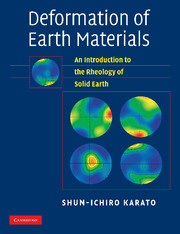Book contents
- Frontmatter
- Contents
- Preface
- Part I General background
- Part II Materials science of deformation
- 4 Elasticity
- 5 Crystalline defects
- 6 Experimental techniques for study of plastic deformation
- 7 Brittle deformation, brittle–plastic and brittle–ductile transition
- 8 Diffusion and diffusional creep
- 9 Dislocation creep
- 10 Effects of pressure and water
- 11 Physical mechanisms of seismic wave attenuation
- 12 Deformation of multi-phase materials
- 13 Grain size
- 14 Lattice-preferred orientation
- 15 Effects of phase transformations
- 16 Stability and localization of deformation
- Part III Geological and geophysical applications
- References
- Materials index
- Subject index
- Plate section
9 - Dislocation creep
Published online by Cambridge University Press: 05 June 2012
- Frontmatter
- Contents
- Preface
- Part I General background
- Part II Materials science of deformation
- 4 Elasticity
- 5 Crystalline defects
- 6 Experimental techniques for study of plastic deformation
- 7 Brittle deformation, brittle–plastic and brittle–ductile transition
- 8 Diffusion and diffusional creep
- 9 Dislocation creep
- 10 Effects of pressure and water
- 11 Physical mechanisms of seismic wave attenuation
- 12 Deformation of multi-phase materials
- 13 Grain size
- 14 Lattice-preferred orientation
- 15 Effects of phase transformations
- 16 Stability and localization of deformation
- Part III Geological and geophysical applications
- References
- Materials index
- Subject index
- Plate section
Summary
Plastic deformation can occur by a collective motion of atoms as crystal dislocations. Evidence for dislocation creep in Earth is abundant although other mechanisms such as diffusional creep (see Chapter 8) dominate under some conditions. The rate of deformation due to dislocation motion is proportional to dislocation density and velocity (the Orowan equation). In most cases dislocation density increases with applied stress and dislocation velocity also increases with stress leading to a non-linear relationship between stress and strain rate. However, steady-state dislocation density is achieved only after a certain time or strain and therefore a significant period of transient creep is often observed in dislocation creep. The dislocation velocity for its glide motion is controlled by a variety of resistance forces including the intrinsic resistance caused by the crystal lattice (the Peierls stress, reorganization of dissociated (partial) dislocations), the interaction with impurity (solute) atoms, and mutual interaction. Dislocation motion out of its glide plane (climb) is controlled by the diffusion of atoms. In both glide and climb, the motion of dislocation often occurs in a step-wise manner through the motion of kinks and jogs respectively whose density is in most cases controlled by the thermochemical equilibrium. Consequently, the velocity of dislocations is often sensitive to thermochemical environment such as oxygen and water fugacity. Creep due to dislocation motion involves a number of processes many of which must occur sequentially. As a result, the slowest of these processes usually controls the overall rate of deformation. […]
- Type
- Chapter
- Information
- Deformation of Earth MaterialsAn Introduction to the Rheology of Solid Earth, pp. 143 - 167Publisher: Cambridge University PressPrint publication year: 2008



